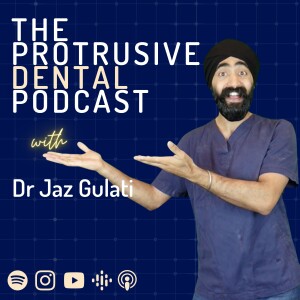
The role of tongue position, posture and the airway on the developing occlusion is hardly covered in Dental School. Let's think BEYOND TEETH with Dr Bobby Supple, carrying on from PDP099.
Follow Protrusive on Instagram!
https://youtu.be/zfLK0qszdA8
Check out this full episode on YouTube
Need to Read it? Check out the Full Episode Transcript below!
Protrusive Dental Pearl: When checking someone’s occlusion after a restoration, do not just check it while they are supine (lying down), sit them up then check their occlusion again because posture does change our occlusion, even just a little.
In this episode we covered:
Skeletal Bite vs Tooth Bite 4:45Trigger Points 13:28Myofunctional Therapy 17:14Dentistry and Other healthcare professionals 24:57Neuromuscular Dentistry 38:19
Check out the book Dr Bobby Supple recommends: New Trends in Myofunctional Therapy
If you enjoyed this episode, check out the first part Occlusion Wars: Which is the Best Occlusal Religion?
Click below for full episode transcript:
Opening Snippet: Okay, so Teeth are together for long periods of time at nighttime, then the sympathetic nervous system stays on. The sympathetic is fight or flight. That's what apnea is. Squeeze, AH...
Jaz' Introduction:Hello, Protruserati. I am Jaz Gulati, and welcome to episode 101. It's a continuation from Episode 99, which was Occlusion wars: Which is the best occlusal religion? And just to give you a flavor of that episode, like a quick recap, I wanted to find out, which is the best training institute for occlusion. Is it Spear? Is it Kois? Is it Dawson? Is it Pankey? Is it neuromuscular? That kind of thing, which is a common question that we all ask on our journey after dental school. And we think that, okay, we need to upskill and learn about comprehensive dentistry and how occlusion fits into it. Very often, we'll be faced with this choice. And some people go for koiss, and some people go for Dawson. And I got someone on Bobby Supple, who continues in this episode. And he blew me away, because he's done so much training with all these greats, he's been in the same room, you know, Kois and spear and Dawson. And everyone's together debating, and he's been very much part of that. And it was great to learn from him. And essentially, it doesn't matter who you train with, they argue and they challenge you on the different processes, the outcomes are going to be very consistent. So the answer is train with whoever you want, whoever is most convenient for you, best price for you, best mentors, maybe your principal, or your boss has also done Kois so you should do Kois. So you can speak the same language maybe, or maybe because your principal's on Kois, you should do Dawson. So you can exchange notes about the how to, and how to get from point A to point B. But essentially, you will do your patient service. And you will do a great job, whoever you choose for your training partner, you make sure you implement it fully, and you do your best. And I think that was a really cool lesson. And going further now from that episode to this episode. The main thing I want to leave you with before we join the main interview is that sometimes, especially when it comes to occlusion, the first time you hear something from an educator, from a speaker, it doesn't quite make sense. And sometimes you have to hear something like for the fifth time, and it's eight years later, and then it clicks in your head because by then you've accumulated enough failures, you've got a bit more experience under your belt, you've got a bit more deep thought and experiences to reflect on. So if this episode is a little bit beyond you, because we do talk about higher level stuff, relevance of the airway, tongue posture, posture in general, this is all stuff that even I'm just learning, grasping more into, because very much, you know, my training was at the two teeth and the skeletal level. The teeth and bones,
view more
More Episodes
Principles of Raising Clean Flaps – PDP126
 2022-08-30
2022-08-30
 2022-08-30
2022-08-30
Red Flags and Alarm Bell Scenarios – IC024
 2022-07-13
2022-07-13
 2022-07-13
2022-07-13
Additive Equilibration Technique – PDP121
 2022-07-08
2022-07-08
 2022-07-08
2022-07-08
012345678910111213141516171819
Create your
podcast in
minutes
- Full-featured podcast site
- Unlimited storage and bandwidth
- Comprehensive podcast stats
- Distribute to Apple Podcasts, Spotify, and more
- Make money with your podcast
It is Free
- Privacy Policy
- Cookie Policy
- Terms of Use
- Consent Preferences
- Copyright © 2015-2024 Podbean.com





